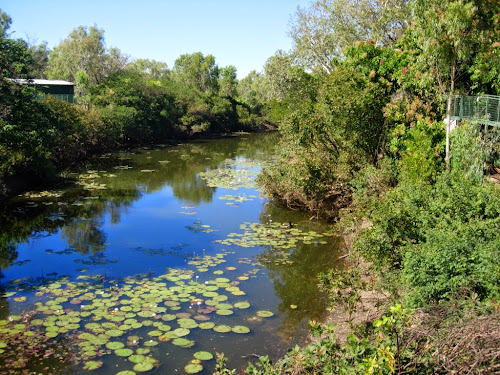We needed directions out of Mulan, so called in at the local clinic. This new facility was spotless and very well maintained. Indeed the whole of Mulan had little or no rubbish and was well cared for.
The road around the Gregory Lake system is just two tyre tracks, mostly over red and orange sand with a few small stony sections. Some ten klms out of Mulan we pulled in to Handover Camp site, one of three sites reserved for tourists to camp. The lake is quite a distance from the camp. The camp had new toilets and huge shady red gums. This campsite is situated on the largest of the lakes (known as Yampirri Yampirri) and is brackish.
We decided to proceed on to the next campsite known as Yunpu. The muster had just been completed and this is where the drovers had camped. The site again was spotless, with new composting toilet, makeshift shower cubicles and fire pit. No one was about, so we had the area to ourselves. Shady melaleucas grew from the white sand and gave shade during the day. A great place to camp.
The drovers had left some excellent logs for the fire, so we had a roaring fire over which we could boil water and create excellent coals for our camp oven. This night we cooked up the crocodile mince, purchased in Alice Springs and had it with vegetables. What does it taste like??????
We think it tastes like a mixture of chicken and fish, very mild.
In the morning we walked down to the lake, known locally as Palpaly, to collect water for a shower. Birdlife abounded on and around the lake. This was also raptor heaven. We counted at least a dozen Wege-Tailed eagles soaring in the skies over the grasslands. Two magpies swooped at and harrassed a young eagle, who was forced to land on the ground a couple of meters from where we were sitting having breakfast. He looked totally perplexed by us and by his situation of having to land in such an undignified way. When it finally flew off, the other eagles also left.

The road out towards the Canning Stock Route from Yunpu had been recently graded, as had the final 125klms of the Canning Stock Route leading to Billiluna. The trucks carrying the cattle from the recent muster had necessitated this occurence. We heard people conversing on the cb radio who were travelling that route from south to north, and soon we caught up with them. They had taken 17 days to complete their trip. A little while later, a convoy of another three vehicles came at us going the opposite direction.
The Canning Stock Route convoy, related a story to us about a mad Dutchman! This fellow had flown in from Holland and was riding his bike along the Route! He had been told in Holland before he left that he could get water from all the wells along the way. The old wells were evenly spaced apart to allow the stockman to get to the next source of water with their cattle in a day's drove, approximately 30klms. Of course, this young man didn't bother to get any local information before setting off into one of the harshest environments on earth, and carried just enough water to take him 50 klms per day! Now, only eight of the original fifty one wells are operational, so here he is, in the Great Sandy Desert, without enough water to get him from water source to water source. The Route is 1619klms long. Thankfully there is plenty of traffic on the route, so he has become reliant on the good nature and generosity of others to survive.
Two nights at Lake Stretch, some 15 klms south of Billiluna is a great treat! Clean fresh water, birdlife in abundance and time to rest the body from all the corregations and dust. The bush campsite again was clean and well maintained.
We had the area to ourselves, the first night, bar two motor bike riders, one of whom had limped along the Tanami Road, and who had been abandoned by his other motor bike friends, when his bike started to give trouble. These so-called friends also abandoned another of their crew after he fell off his bike and broke his collarbone, because he was travelling too slowly!
The second night, two lovely young women came to camp, Aria and Kirsty. They had both completed a year-long motor mechanic course at TAFE, which comprised of 22 days of full 8 hours work and included some bush mechancs. They were travelling by themselves in very remote areas, with spares and recovery gear. We thought they were very enterprising, highly capable and very interesting. They had been on the road since March.






































